
The San Francisco cable car system is the world's last manually operated cable car system. An icon of San Francisco, the cable car system forms part of the intermodal urban transport network operated by the San Francisco Municipal Railway. Of the 23 lines established between 1873 and 1890, only three remain : two routes from downtown near Union Square to Fisherman's Wharf, and a third route along California Street. While the cable cars are used to a certain extent by commuters, the vast majority of their seven million annual passengers are tourists, and as a result, the wait to get on can often reach two hours or more. They are among the most significant tourist attractions in the city, along with Alcatraz Island, the Golden Gate Bridge, and Fisherman's Wharf. The cable cars are listed on the National Register of Historic Places.
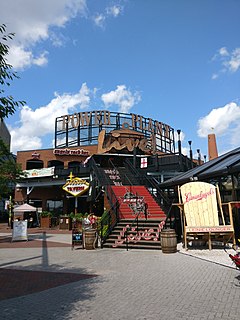
Power Plant Live! is a collection of bars, restaurants and other businesses in the Inner Harbor section of downtown Baltimore, Maryland. It was developed by The Cordish Companies and opened in phases during 2001, 2002, and 2003. The entertainment complex gets its name from the nearby "Power Plant" building, three blocks south on municipal Pier 4 on East Pratt Street facing the Inner Harbor, which was also later re-developed by Cordish.

Streetcars in Washington, D.C. transported people across the city and region from 1862 until 1962.

The St. Charles Streetcar line is a historic streetcar line in New Orleans, Louisiana. It is the oldest continuously operating streetcar line in the world, as it has been in operation since 1835. It is operated by the New Orleans Regional Transit Authority (RTA). Officially the St. Charles Streetcar line is internally designated as Route 12, and it runs along its namesake street, St. Charles Avenue. It is the busiest route in the RTA system as it is heavily used by local commuters and tourists. On most RTA maps and publications, it is denoted in green, which is also the color of the streetcars on this line.

The Charles Theatre, often referred to as simply The Charles, is the oldest movie theatre in Baltimore. The theatre is a Beaux-Arts building designed as a streetcar barn in 1892 by Jackson C. Gott, located in what is now the Station North arts and entertainment district. The theater was renamed the Charles circa 1959 and became a calendar revival house in 1979. Many of John Waters's early films premiered at this theatre; this honor has since shifted to the Senator Theatre.

The National Capital Trolley Museum (NCTM) is a 501(c)(3) nonprofit organization that operates historic street cars, trolleys and trams for the public on a regular schedule. It is located at 1313 Bonifant Road, Colesville, Maryland USA. The museum's primary mission is to preserve and interpret the history of the electric street and interurban railways of the National Capital region.
The Capital Traction Company was the smaller of the two major street railway companies in Washington, D.C., in the early 20th century. It was formed through a merger of the Rock Creek Railway and the Washington and Georgetown Railroad Company in 1895. The company ran streetcars from Georgetown; Capitol Hill; Chevy Chase, MD; the Armory and Mt. Pleasant. In 1933 it merged with its major competitor the Washington Railway and Electric Company to form the Capital Transit Company.
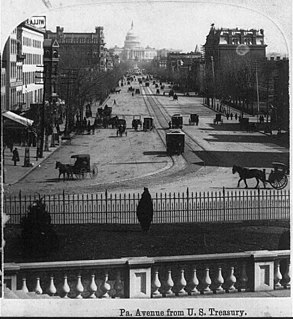
The Washington and Georgetown Railroad Company was the first streetcar company to operate in Washington, D.C. It was incorporated and started operations in 1862, using horse-drawn cars on tracks between Georgetown and the Navy Yard. Two additional lines ran on 7th Street NW/SW and 14th Street NW. In 1890, it switched to cable cars. On September 21, 1895, the company was purchased by the Rock Creek Railway and the two formed the Capital Traction Company.

The Ellicott City Station in Ellicott City, Maryland, is the oldest remaining passenger train station in the United States, and one of the oldest in the world. It was built in 1830 as the terminus of the Baltimore and Ohio Railroad line from Baltimore to the town then called Ellicott's Mills, and a facility to service steam locomotives at the end of the 13-mile (21 km) run. The station, a National Historic Landmark, is now used as a museum.

Mount Clare, also known as Mount Clare Mansion and generally known today as the Mount Clare Museum House, is the oldest Colonial-era structure in the City of Baltimore, Maryland, U.S.A. The Georgian style of architecture plantation house exhibits a somewhat altered five-part plan. It was built on a Carroll family plantation beginning in 1763 by barrister Charles Carroll the Barrister, (1723–1783), a descendant of the last Gaelic Lords of Éile in Ireland and a distant relative of the much better-known Charles Carroll of Carrollton, (1737–1832), longest living signer of the Declaration of Independence and the richest man in America in his later years, also the layer of the First Stone of the new Baltimore and Ohio Railroad, just a short distance away in 1828.

Cumberland station is a historic railway station in Cumberland, Allegany County, Maryland. It was built in 1913 as a stop for the Western Maryland Railway (WM). The building was operated as a passenger station until the WM ended service in 1959, and it continued to be used by the railway until 1976. It was subsequently restored and currently serves as a museum and offices, as well as the operating base for a heritage railway.
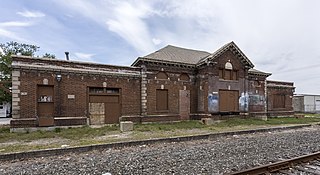
Union Station is a historic railway station located at Salisbury, Wicomico County, Maryland, United States. It was constructed in 1913–14, near the junction where the New York, Philadelphia & Norfolk Railroad intersected with the Baltimore, Chesapeake and Atlantic Railroad in the center of Salisbury. Both railroads became part of the Pennsylvania Railroad (PRR). It has a 1 1⁄2-story, Flemish bond brick main block covered by a medium-pitched hip roof sheathed in slate, with single-story wings. From the 1920s to the 1950s, the PRR ran several passenger trains a day, including the Del-Mar-Va Express, through the station, north-south from Philadelphia to Cape Charles, Virginia.
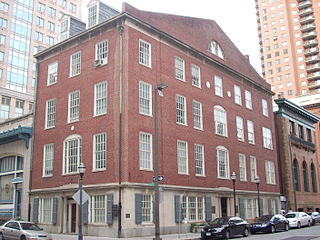
Canton House is a historic office building located on the northeast corner of Water Street and South Street in Baltimore, Maryland, United States. It is a 4 1⁄2-story Colonial Revival-style building, with seven bays across the front façade of Water Street to the south and three bays across the side facing South Street to the west. The first story level is in marble and brick is laid in Flemish bond from the second story up. It has a sloped peaked roof with two dormer windows facing west to the side. The main entrance features two fluted Corinthian stone columns.

Hendler Creamery is a historic industrial complex in Jonestown, Baltimore, Maryland. Since it spans an entire block it has addresses at 1100 E. Baltimore St. and 1107 E. Fayette St. "The Hendler Creamery is historically significant for its contribution to the broad patterns of history in three areas of significance: transportation, performing arts, and industry."
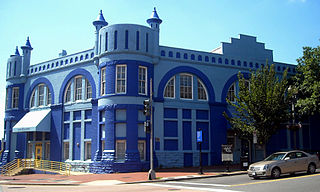
The Washington and Georgetown Railroad Car House, also known as the Navy Yard Car Barn, or Blue Castle, is an historic building, located at 770 M Street, Southeast, Washington, D.C.
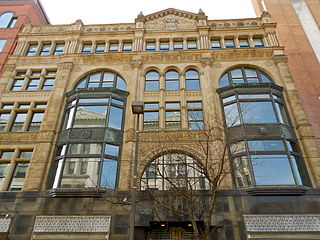
Baldwin & Pennington was the architectural partnership with Ephraim Francis Baldwin (1837-1916) and Josias Pennington (1854-1929) based in Baltimore, Maryland. The firm designed an incredibly large number of prominent structures throughout the Middle Atlantic region, especially as the "house architects" of the Baltimore and Ohio Railroad, including many of its stations and other late 19th century structures for the railroad. Several of their works are listed on the United States' National Register of Historic Places, maintained by the National Park Service of the U.S. Department of the Interior.

The Cable Building is located at 611 Broadway at the northwest corner with Houston Street in NoHo and Greenwich Village, in Manhattan, New York City. Since it spans a block, the Cable Building also has addresses of 2-18 West Houston Street and 178-188 Mercer Street.

The Patapsco Hotel is historic granite building located in Ellicott City, Maryland, on the western bank of the Patapsco River.
The Baltimore City Passenger Railway began operation on July 12, 1859 using horse-drawn cars.
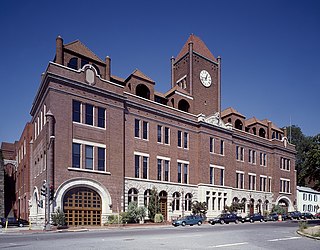
The Georgetown Car Barn, historically known as the Capital Traction Company Union Station, is a building in the Georgetown neighborhood of Washington, D.C., in the United States. Designed by the architect Waddy Butler Wood, it was built between 1895 and 1897 by the Capital Traction Company as a union terminal for several Washington and Virginia streetcar lines. The adjacent Exorcist steps, later named after their appearance in William Friedkin's 1973 horror film The Exorcist, were built during the initial construction to connect M Street with Prospect Street.
























